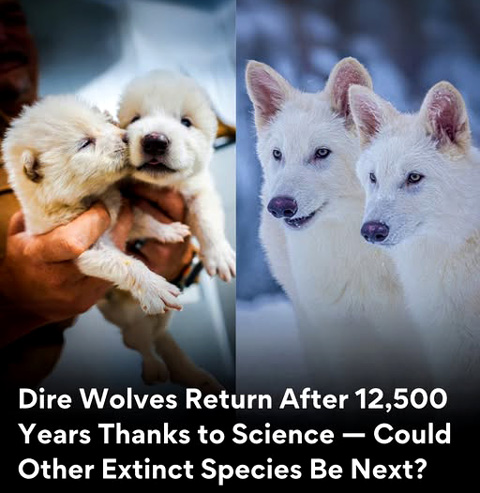DE Online Desk
The dire wolf was one of the most formidable predators in the Americas during the last Ice Age, possessing a body more stout and a skull more robust than those of modern wolves.
The species went extinct along with many others as the Ice Age ended.
Roughly 13,000 years later, a US company has taken a step aimed at bringing the dire wolf back from oblivion – aside from the TV versions in the popular “Game of Thrones” fantasy series.
Dallas-based Colossal Biosciences has announced the birth of three genetically engineered wolf pups – all with striking white fur – created with the help of ancient DNA obtained from fossilized remains of dire wolves.
The company is calling them dire wolves and is referring to this as the world’s first successfully “de-extincted” animal.
The company can use the same approach to resurrect other extinct species for which ancient DNA is available.
Outside experts are more cautious, describing the pups as genetically modified gray wolves because the process used to create them involved editing the genes of that species to add dire wolf traits.
The gray wolf is the closest living relative of the dire wolf.
There are two male pups, named Romulus and Remus after Rome’s legendary founders who were suckled by a she-wolf, and one female, named Khaleesi in honor of a “Game of Thrones” character.
All three are large for their age compared to gray wolves, according to Beth Shapiro, Colossal’s chief science officer.
Romulus and Remus, both six months old, are around 80 pounds (36 kg) while Khaleesi, at two months old, is around 25 pounds (11 kg).
Dire wolves were as much as 25 percent bigger than gray wolves, with a slightly wider head and a stronger jaw, the company said.
Company scientists extracted ancient DNA from two dire wolf fossils – a tooth from Sheridan Pit, Ohio, approximately 13,000 years old, and an inner ear bone from American Falls, Idaho, roughly 72,000 years old.
Twenty genes of gray wolves were edited with this DNA to include dire wolf traits in gray wolf cells.
Through cloning, scientists created embryos from the edited gray wolf cells, and they implanted them in surrogate domesticated dog mothers.
Three different dogs gave birth to the pups.
“We define de-extinction success as bringing back the functional ecological traits that made dire wolves unique contributors to their ecosystem, and our dire wolves are an example of that,” Shapiro said.
Asked whether it is proper to call the pups dire wolves, Shapiro said, “I feel like this debate misses the point a bit.
Remember that species classifications are human constructs that often don’t map well onto natural populations. We invented them to help make sense of the natural world.”
“De-extinction is not creating perfect genetic copies of individual animals.
It’s about restoring lost ecological functions and enhancing biodiversity,” Shapiro added.
‘SLIGHT MODIFICATIONS’
Corey Bradshaw, a professor of global ecology at Flinders University in Australia, voiced skepticism about the company’s announcement and the practicality of reviving an extinct species.
“So yes, they have slightly genetically modified wolves, maybe. And that’s probably the best that you’re going to get.
And those slight modifications seem to have been derived from retrieved dire wolf material.
Does that make it a dire wolf? No. Does it make a slightly modified gray wolf? Yes,” Bradshaw told Reuters TV.
Shapiro said the pups are thriving on a secure ecological preserve spanning more than 2,000 acres (810 hectares).
The company did not give the location.
Shapiro said they eventually could weigh 100 to 150 pounds (45-68 kg) and stand 32 to 40 inches (81-102 cm) at the shoulder.
Dire wolves once roamed widely in North and South America as one of the most successful Ice Age predators, alongside the likes of saber-toothed cats and giant short-faced bears. In North America, scientists have discovered the fossils as far north as Alaska and down into southern Mexico.
Numerous dire wolf fossils have been found at the Rancho La Brea tar pits site in Los Angeles.
Previous research could not resolve their evolutionary origin, causing speculation that jackals may be their closest living relative.
Colossal said its high-quality dire wolf genome revealed that the gray wolf is the closest living relative, sharing 99.5 percent of their DNA code with dire wolves.
Its scientists also determined that the dire wolf lineage emerged between 3.5 and 2.5 million years ago as a consequence of hybridization between two ancient lineages of canids.
“Some extinct species, like the dire wolf, hold deep cultural significance for indigenous peoples or played important roles in human history.
Their restoration could help preserve cultural heritage and traditional ecological knowledge,” Shapiro said.

